«Atomic Diffusion In Glasses»
Glasses mixed with ions like alkali borate glasses or alkali silicate glasses have high technological potentials for electrochemical devices such as solid-oxide fuel cells, solid-state batteries or chemical sensors. In the contrast to conventional liquid lithium-ion-batteries, these materials have a low self-discharge, a fast load capacity, a high stability, a high energy density and a reasonable and easy producibility.
Much of the interest of these materials lie in their future applications; imagine solid-state electrolytes like thin ionic glass plates instead of a lithium ion-liquid. Thinking of e-cars, the time-consuming charging compared to the fast refueling of conventional cars is still a major issue. There exists the idea not to simply charge, but to exchange the rundown accumulators with fully charged ones within seconds. Instead of refueling liquid electrolytes, which are very toxic and dangerous one could do a quick change of ionic glass plates.
![[Dif01]](/fileadmin/_processed_/csm_DIFF_01_e-cars_82fffc0479.jpg)
The properties of these materials could allow building skyscrapers with huge glass facades, where one layer of the glass is made of photovoltaic cells and generates energy while the next layer stores the energy like solid state electrolytes made of ionic glass would do.
![[Dif02]](/fileadmin/_processed_/csm_DIFF_02_energy_house_02509b1e86.jpg)
The aim of the research is to utterly characterise microscopic
properties with the aid of experiments, numerical simulations and
theoretical models and eventually reveal the atomic diffusion in ionic glasses.
WAXS (Wide Angle X-ray Scattering)
(Wide Angle X-ray Scattering) experiments help us to achieve information of the static structure of vitreous materials, while aXPCS (atomic-scale X-ray Photon Correlation Spectroscopy) experiments provide us with the information of dynamical properties. Additionally computer simulations are necessary to distinguish between different types of atoms in polyatomic systems.
Compared to other experimental techniques aXPCS is a very young discipline, hence, it is just at the beginning of its application. Not long ago it was found that aXPCS experiments cause beam-induced dynamics in oxide glasses, which on the one hand is a hindrance to obtain the actualintrinsic* dynamical properties of these materials, but on the other hand open new possibilities of characterising them. The beam-induced effect is also one of the major topic we are interested in.
![[Dif03]](/fileadmin/_processed_/csm_DIFF_03_beam_induced_dynamics_6ae595e802.jpg)
Scattering experiments allow us to look inside the material on a microscopic level. The incident X-ray beam gets scattered at the atoms of the sample. These scattered waves interfere with each other and are counted by the detector. For amorphous materials the interference pattern is characterised by rings, the so-called Debye-Scherrer rings.
Imagine throwing a stone into the lake, which causes wave-like rings that propagate from the center of the immersing stone to the outside. Thus, throwing many stones into the lake cause an interference pattern of many evolving rings. The brightness and the thickness of the rings and the relative distances between them provide information of the atomic arrangement of the observed material.
In physical jargon one speaks about reciprocal space when analyzing these interference patterns, which means analyzing the intensity I versus the scattered wave vector q. Structural properties are accessible via Fourier-transformation of these I(q) data into real space.
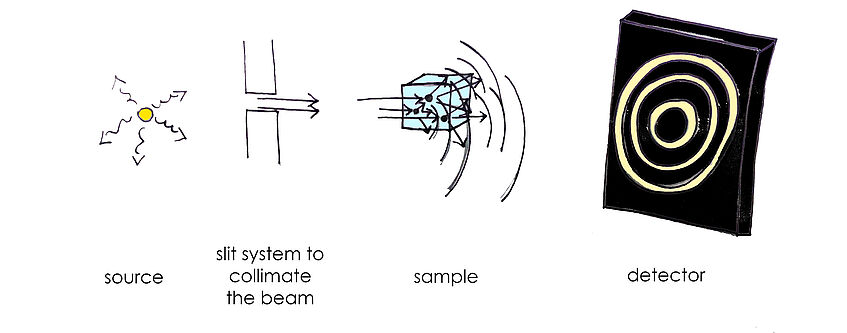
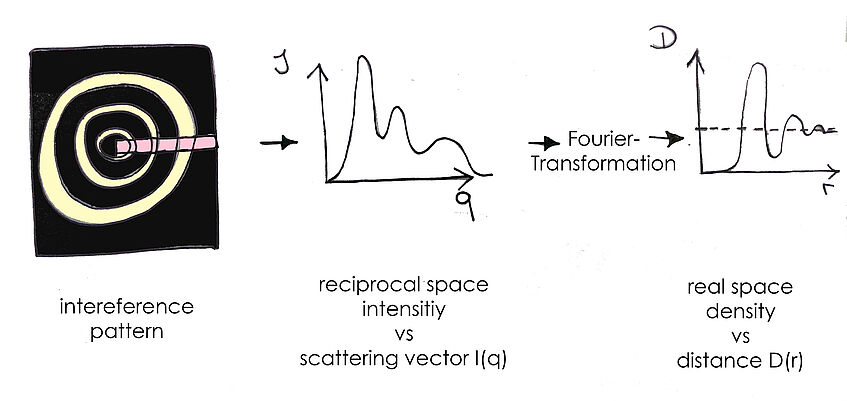
The structural analysis of amorphous materials in real space is characterised by density fluctuations. High peaks, denoted by Gaussian distributions, of the density versus distance represent a higher possibility of finding neighbouring atoms at this specific atomic distance.
![[Dif07]](/fileadmin/_processed_/csm_DIFF_Inhalt_final_010_un-cropped_05f1b29844.png)
Density function D vs. distance r between the atoms of lithium borate glass
Borate structure
Alkali borate glasses show three main types of structural arrangements:
![[Dif06]](/fileadmin/_processed_/csm_DIFF_7.Sepiol-_-Inhalt-_final_-006_5c31321bea.jpg)
Intensity I vs. scattering vector q of lithium borate glass
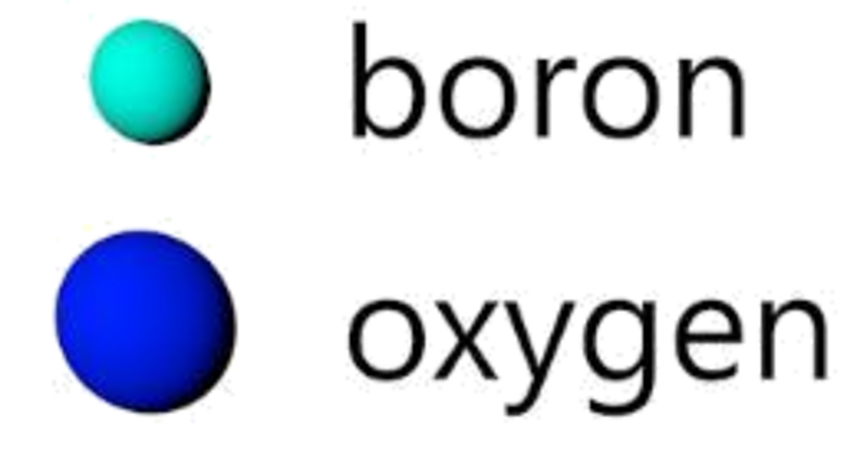
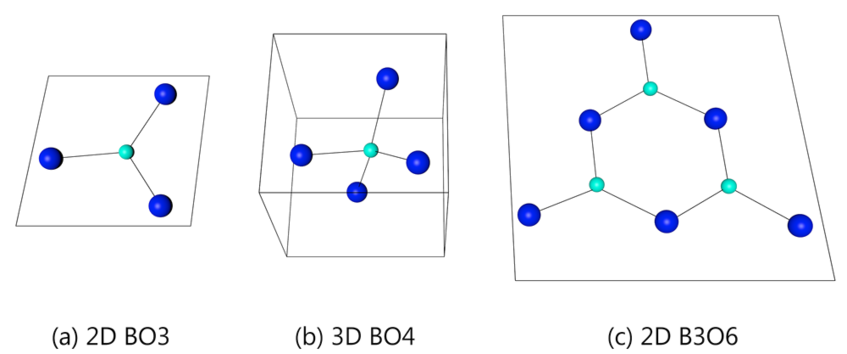
BO3 planar triangles; one positive charged boron atom equally surrounded by three negative chargedoxygen atoms. They are 2-dimensional in space, 2D
BO4 tetrahedrons; one positive charged boronatom surrounded by four negative charged oxygenatoms. They are 3-dimensional in space, 3D.
BO4 tetrahedrons; one positive charged boronatom surrounded by four negative charged oxygenatoms. They are 3-dimensional in space, 3D.
With the increasing amount of BO4 molecules, the mobility of the ions, hence the conductivity of thevitreous material, increases. This increasing amount of BO4 can be seen by a slight shift of the firstdensity peak to a higher distance due to the fact that the bonding length of BO4 molecules between the boron and the oxygen atom is slightly longer than that of BO3
![Alkali borate [Dif09]](/fileadmin/_processed_/csm_DIFF_10_alkali_borate_strucutre_f44ae818af.jpg)
![[Dif10]](/fileadmin/_processed_/csm_DIFF_7.Sepiol-_-Inhalt-_final_-010_a1953a9e26.jpg)
The amount and the type of alkali atoms is crucial for the formation of BO4 structures. The positive charged ions are more likely to move when residing next to a BO4 configuration and lazier when residing next to BO3 structures. Mixing glasses with heavy alkali atoms like caesium tend to suppress the formation of BO4 molecules.
Atomic-scale X-ray Photon Correlation Spectroscopy (aXPCS)
The idea is simple: instead of shooting only one picture of the reciprocal space via X-ray diffraction, many pictures are shot behind one another. Thus, a movie of diffracted interference pattern is created, which is related to the motion of the atoms inside the sample. Zooming into the picture ofDebye Scherrer rings leads to the so-called speckle pattern, which represents a distribution ofdiffracted points that is changing from frame to frame.
![[Dif11]](/fileadmin/_processed_/csm_DIFF_12_aXPCS_experiment_0ea6b3899c.jpg)
Correlating the series of frames in time give us information of diffusion processes in dependence of the scattering vector q, the incident flux* of the beam and the temperature.
Inside alkali borate structure
The video shows the interior of an alkali borate glass sample. The ions are moving through the structure, whereas the structure itself is vibrating. The positive charged ion won't reside next to another positive ion, respectively next to a positive boron atom. Favoured are negative charged oxygen atoms. One should imagine the ionic motion more as jumps than fluent movements. Hence, it is hopping from appropriate free sites to another.
Beam-induced dynamics
Measuring and manipulating the sample at the same time is a well known effect when using X-ray radiation with a high energy. The worst case would be destroying the sample while measuring, which biological samples like proteins are often suffering from. Investigating oxide glasses withaXPCS causes an additional dynamical effect. This effect is reversible. This means, that it does not trigger any long-term changes of the dynamics nor the structure of the observed oxide glass. The effect depends on the incident flux of the beam.
![[Dif13]](/fileadmin/_processed_/csm_DIFF_14_me_dancing_3306dff92e.jpg)
Imagine a dancer on stage. It is dark and nobody watches her. She is moving very slow. As the spotlights get brighter and brighter the audience is able to watch her and she starts moving faster and faster in every direction. The audience represents a scientist, who is only able to observe the motion of atoms (dancers) while exposing them with light: the higher the flux of the incident light, the faster the motion of the atoms.
Correlation function
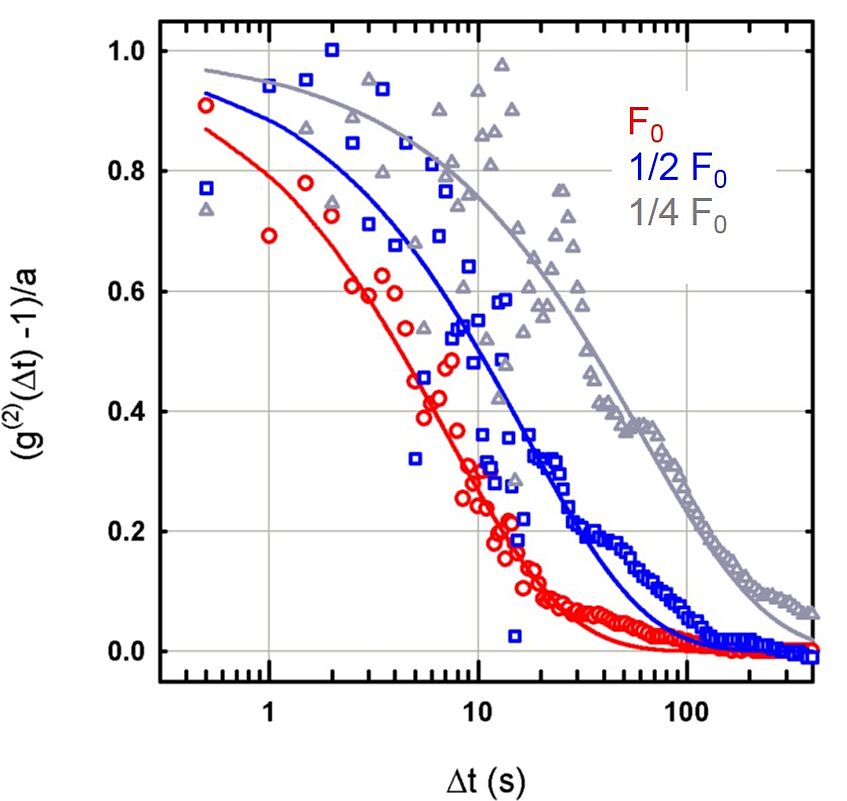
Correlation function
The decrease of thecorrelation function g(2)(Δt) (logarithmically plotted) reflects the diffusion of the atoms. The faster the decrease in time Δt, the faster the motion of the atoms. The figure on the right shows that half of the flux 1/2 F0means a slower atomic motion (blue curve).
Having a closer look at alkali oxide glasses, it also depends on the alkali concentration: when increasing the amount of alkali atoms (figure: blue: 2% of Rb2O , purple: 15% of Rb2O ), the effect of the beam becomes weaker (figure: the slope of the linear curves decrease).
![[Dif15]](/fileadmin/_processed_/csm_DIFF_16Rb_tau_flux_Bogdan_9aee4a239b.jpg)
When we measured pure borate glass B2O3 without any alkali concentration we expected no recognisable dynamics in the sample. Surprisingly we also saw this effect, which leads to the assumption that not only the mobile ions, but also the oxygen and boron atoms are moving. The correlation time τ is a parameter of the correlation function:
The smaller τ, the faster the diffusion. In the figure below pure B2O3 and different concentrations of rubidium borate glasses are plotted. The smaller the reciprocal value of the flux, the smaller τ.
The beam-induced effect depends on the sample itself. Insulators like pure B2O3, metallic materials,semi-conducting or ion-conducting materials like alkali borate or alkali silicate glasses behave differently to the X-ray beam. Hence, it could be possible to indirectly investigate bonding properties with this effect. This recently discovered effect is still in the early stages of investigation and needs to be thoroughly investigated in order to be fully understood.
Beam induced dynamics
The video shows the difference between a beam-induced diffusion on the right and an intrinsic diffusion on the left of an alkali borate sample.
Research team
Principal Investigator: Prof. Bogdan Sepiol
- Sketches and Videos: Katharina Holzweber
- Diagrams: Christoph Tietz, Bogdan Sepiol, Katharina Holzweber
- Experiment, Evaluation: Christoph Tietz, Michael Legenstein, Bogdan Sepiol, Katharina Holzweber
- Layout and Text: Katharina Holzweber
Source Material - Attribution
[Dif01] E-cars © Bogdan Sepiol, Universität Wien
[Dif02] Energy house © Bogdan Sepiol, Universität Wien
[Dif03] Beam induced dynamics © Bogdan Sepiol, Universität Wien
[Dif04] WAXS Experiment © Bogdan Sepiol, Universität Wien
[Dif05] WAXS Evaluation © Bogdan Sepiol, Universität Wien
[Dif06] Intensity vs. Scattering © Bogdan Sepiol, Universität Wien
[Dif07] Density function vs. distance © Bogdan Sepiol, Universität Wien
[Dif08] Borate structure © Bogdan Sepiol, Universität Wien
[Dif09] Alkali borate © Bogdan Sepiol, Universität Wien
[Dif10] Density function © Bogdan Sepiol, Universität Wien
[Dif11] aXPCS Experiment © Bogdan Sepiol, Universität Wien
[Dif12] Inside alkali borate structure © Bogdan Sepiol, Universität Wien
[Dif13] Dancer © Bogdan Sepiol, Universität Wien
[Dif14] Correlation function © Bogdan Sepiol, Universität Wien
[Dif15] Autocorrelation time © Bogdan Sepiol, Universität Wien
[Dif16] Beam induced dynamics (video) © Bogdan Sepiol, Universität Wien
